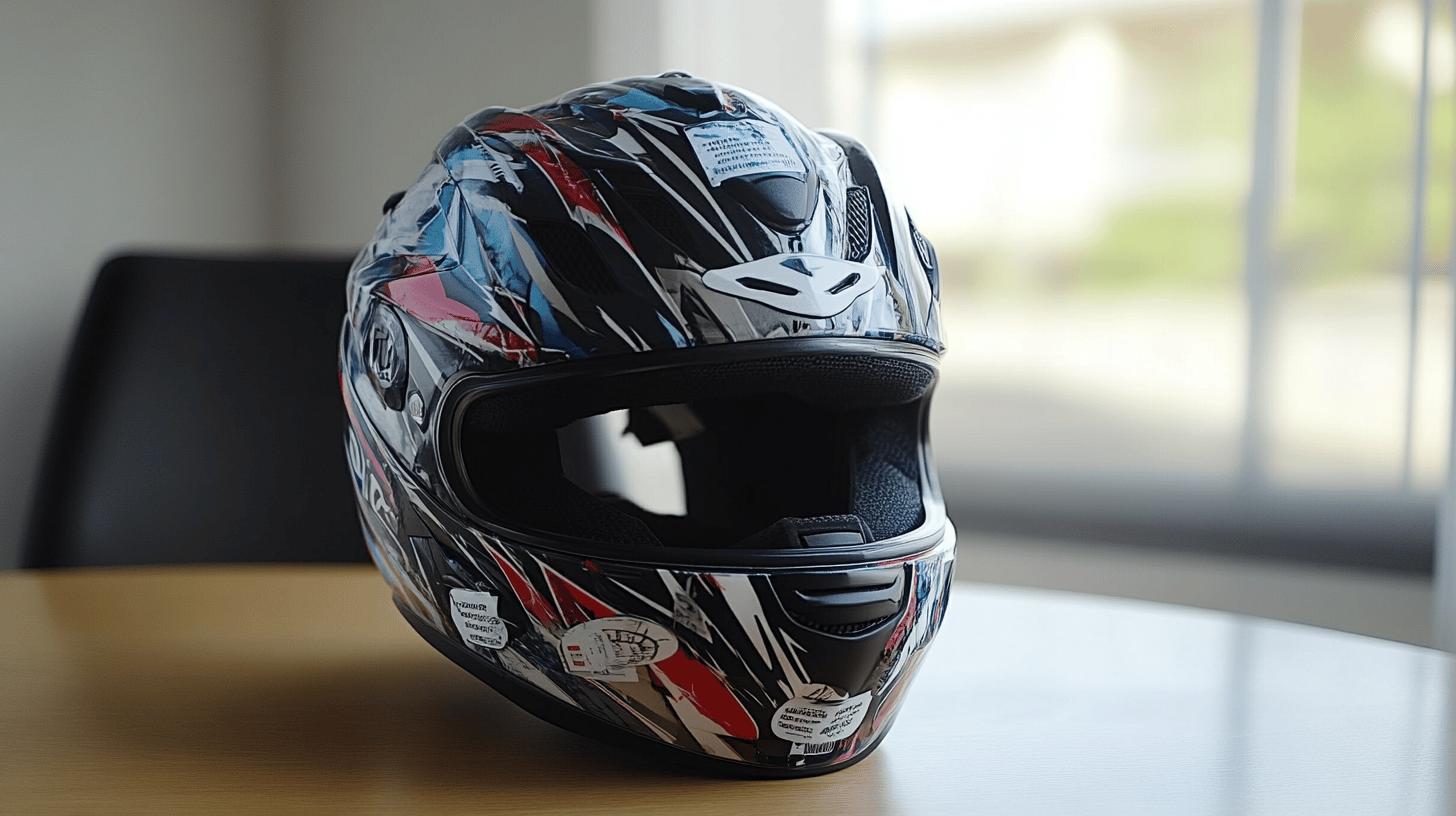Wondering if decorating your motorcycle helmet with stickers is a smart choice? Customizing helmets with stickers can express individuality and style, but it's not as simple as slapping any adhesive onto your gear.
Dive into this guide, "How to Put Stickers on a Motorcycle Helmet," and learn the strategic methods, tools, and tips to make your helmet stand out without compromising safety.
From selecting the right materials to ensuring optimal adhesion and durability, this article covers everything you need for a flawless sticker application that both looks great and lasts.
Materials Needed for Applying Stickers on a Motorcycle Helmet

Utilizing the correct materials is crucial to achieving a successful sticker application on a motorcycle helmet. The right tools ensure the process is smooth and the stickers adhere properly without damaging the helmet surface.
Selecting quality materials not only simplifies the application process but also extends the durability and appearance of the stickers.
-
Stickers
-
Clean cloth
-
Mild detergent
-
Rubbing alcohol
-
Squeegee or credit card
-
Hairdryer or heat gun
-
Tweezers
-
Masking tape
Adhesive types play a significant role in how well stickers adhere to the helmet. Adhesives need to be compatible with the helmet material to prevent any potential damage or weakening of the helmet's structure.
Some adhesives are specifically designed for use with certain materials, such as polycarbonate or fiberglass, ensuring they bond effectively without causing harm. When selecting stickers, consider the adhesive type to maintain the helmet's integrity and ensure long-lasting adhesion.
Preparing Your Helmet Surface for Sticker Application

Thorough surface preparation is paramount for successful sticker adhesion on a motorcycle helmet. Begin by cleaning the helmet with a solution of mild detergent and warm water. This step removes dirt, dust, and other particles that could hinder adhesion.
Use a clean cloth to gently scrub the helmet, paying special attention to any crevices or textured areas. Once cleaned, rinse the helmet thoroughly to eliminate any soap residue and pat it dry with a lint-free cloth to prevent water spots.
Removing grease and residue is critical, as these substances can significantly impair sticker adhesion. Rubbing alcohol is highly effective for this purpose. Apply a small amount to a clean cloth or cotton pad and wipe down the entire surface of the helmet.
This process not only removes any lingering oils but also evaporates quickly, leaving the surface pristine and ready for sticker application. Ensure that you cover all areas where stickers will be placed, as even a small amount of grease can affect the final result.
A completely dry helmet is essential to achieve optimal sticker adhesion. Moisture can compromise the adhesive properties of stickers, leading to peeling or bubbling. Allow the helmet to air dry completely after cleaning and alcohol application.
If time is a constraint, a soft, dry cloth can be used to hasten the drying process. Before proceeding with sticker application, inspect the helmet under good lighting to confirm that it is entirely dry and free from any unwanted residues.
Step-by-Step Guide to Applying Stickers on a Motorcycle Helmet

Planning the placement of your stickers is a critical first step in the application process. This ensures that the final look is cohesive and visually appealing. Begin by arranging the stickers on the helmet without removing their backing. This step allows for experimentation with different layouts and positions, enabling you to envision the ultimate design.
Take into account the helmet's curves and contours, as these will affect how the stickers sit. Proper planning helps prevent misalignment and ensures that the stickers enhance the helmet's appearance without interfering with safety features.
To achieve a flawless application, follow these steps:
-
Clean and dry the helmet: Ensure the surface is free from dust and grease.
-
Plan sticker placement: Arrange stickers on the helmet to visualize the design.
-
Peel the backing: Carefully remove the sticker's backing starting from one edge.
-
Apply the sticker: Place it gently onto the helmet, smoothing from the center outward.
-
Use a squeegee: Press the sticker firmly to eliminate air bubbles.
Effective bubble prevention is key to a professional-looking sticker application. A squeegee or a credit card can be a handy tool for this task. After placing the sticker on the helmet, use the squeegee to press it down firmly.
Start from the center of the sticker and work your way outwards towards the edges. This method helps push out any trapped air, preventing unsightly bubbles that can mar the sticker's appearance. Consistent pressure and a steady hand will ensure the sticker adheres smoothly and evenly.
When dealing with curved surfaces, a few additional techniques can aid in achieving a seamless finish. Gently heating the sticker with a hairdryer or heat gun makes it more pliable, allowing it to conform more easily to the helmet's shape. Apply heat sparingly and evenly, being cautious not to overheat and damage the sticker.
As the sticker becomes more flexible, use your fingers or a squeegee to smooth it into place, taking extra care around edges and transitions. This approach ensures a snug fit that enhances both the helmet's aesthetics and the sticker's durability.
Enhancing Sticker Adhesion and Durability

Applying heat can significantly improve sticker adhesion, particularly on curved surfaces of a motorcycle helmet. How can heat aid in sticker application? Gently heating the sticker with a hairdryer or heat gun makes it more malleable, allowing it to conform more easily to the helmet's shape. This flexibility reduces the risk of bubbles and ensures a snug fit.
When using heat, apply it evenly and sparingly to avoid damaging the sticker or the helmet surface. This technique provides a more seamless and professional finish, enhancing both the sticker's appearance and its grip on the helmet.
-
Use high-quality vinyl stickers designed for outdoor use.
-
Avoid touching the adhesive side with fingers to maintain its stickiness.
-
Regularly check for peeling edges and press them back down promptly.
Allowing stickers to set properly before exposing them to moisture or extreme temperatures is crucial for durability. Why is this waiting period important? Setting time helps the adhesive bond fully with the helmet surface, providing a strong and lasting hold.
Stickers should be left undisturbed for at least 24 hours after application. This period ensures that they adhere securely and are less likely to peel off or shift position when subjected to environmental factors like rain or sunlight. Proper adherence not only extends the life of the stickers but also maintains the integrity of the design on the helmet.
Legal and Safety Considerations for Helmet Stickers

Checking local regulations is crucial before applying stickers to a motorcycle helmet. Why is this step necessary? Different regions have varying laws regarding helmet modifications, and non-compliance can result in fines or legal issues. Some areas might have specific guidelines on what types of stickers are permissible, while others may prohibit any alterations that could affect the helmet's integrity or safety certification. Therefore, understanding and adhering to these regulations ensures that your helmet remains legally compliant and safe for use.
Maintaining visibility of safety certifications and avoiding obstruction of helmet vents are key safety considerations. Why is this important? Safety certifications, often displayed as stickers or labels, verify that the helmet meets established safety standards.
Covering these with additional stickers could obscure proof of compliance in the event of an inspection. Similarly, helmet vents play a vital role in ventilation and rider comfort.
Stickers should not obstruct these features, as doing so could impede airflow and affect the helmet's performance. Careful placement of stickers ensures that safety and functionality are not compromised.
Final Words
Mastering the art of sticker application on a motorcycle helmet begins with gathering the right materials and understanding adhesive compatibility. Proper surface preparation ensures optimal sticker adhesion.
Following a step-by-step approach helps in achieving a bubble-free and smooth finish, while applying heat enhances sticker durability. Always keep in mind legal and safety considerations to maintain helmet integrity.
Learning how to put stickers on a motorcycle helmet adds personal flair to your ride, enhancing the overall experience.
FAQ
How to put stickers on a motorcycle helmet without wrinkles?
To put stickers on a motorcycle helmet without wrinkles, start by cleaning the surface thoroughly, plan placement, and apply slowly while smoothing with a squeegee or credit card to avoid bubbles.
Can I put stickers on my motorcycle helmet?
Yes, you can put stickers on your motorcycle helmet, but make sure to check local regulations and avoid covering important features like certifications or vents.
Where is the best place to put stickers on a helmet?
The best place to put stickers on a helmet is on flat or gently curved surfaces. Avoid edges and areas with raised features or safety certifications.
Is it safe to put stickers on a bike helmet?
It is often safe to put stickers on a bike helmet, provided they do not impair the helmet’s structural integrity or cover ventilation or certification markings.
How to put stickers on a hard hat without wrinkles?
To apply stickers on a hard hat without wrinkles, thoroughly clean the surface, carefully position the sticker, and use a gentle, even pressure with a squeegee while applying.
Can you put vinyl on a motorcycle helmet?
Yes, you can put vinyl on a motorcycle helmet, ensuring the adhesive is compatible with the helmet material to prevent damage or peeling over time.

Ryan Thompson is a 35-year-old sport bike enthusiast known for his adventurous spirit. With years of weekend rides and exploring new roads, Ryan brings fresh insights and firsthand experience to ProtectiveGearz. His energetic approach and passion for the latest gear make him a trusted source for riders seeking up-to-date advice.



